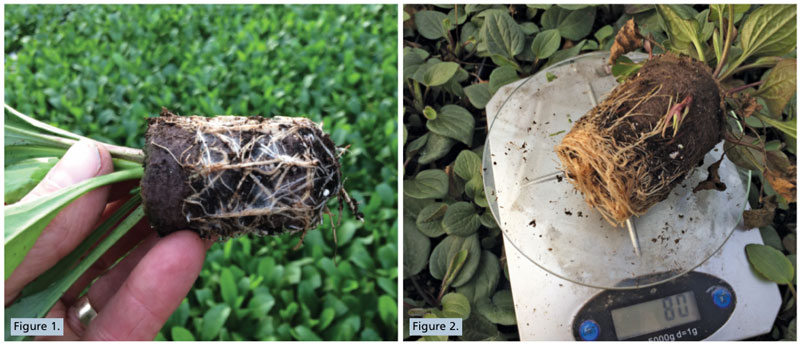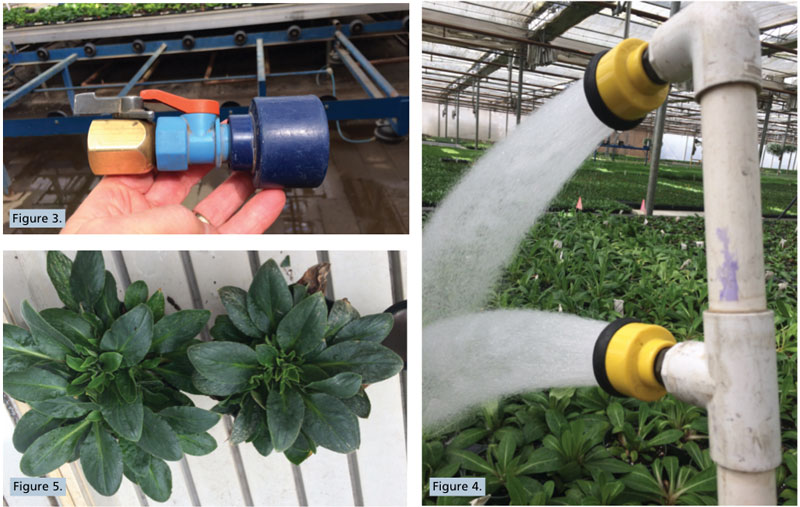7/1/2018
Irrigation Specialists
Roger McGaughey
How was spring for everyone this year? Apart from being late weather-wise, especially in the Northeast, how much shrink has there been due to bad watering?
It’s often said that the person with the hosepipe in their hand is one of the most important employees on the nursery. I firmly believe that good waterers are worth their weight in gold and that it’s extremely important to give these employees as much training as possible to enable them to produce quality plants.
We growers are really good at killing plants by either over- or under-watering, so someone who applies the right amount of liquid, either water or fertilizer, is the specialist that everyone would like to employ.
I’d like to reference an e-GRO webinar that I think is extremely valuable to incorporate into any training program: “The Science and Art of Watering” by Allen Hammer. In this webinar, Allen very effectively addresses the soil mix properties, which affect how a plant uses water and gives us insight into how to create the “just right” waterer.
Ideally, anyone who enjoys watering and has a flair for it is the ideal person to have on your growing team, but, unfortunately, these employees are few and far between. So it’s in our interest to create these applicators. As management, we need to devote the time and energy that will help them develop the necessary skills. How many signs does the plant provide to tell us when liquid is required and how many factors affect water usage within the plant? What tools do we provide as training aids?
The plants are always in charge in the greenhouse and they’re always talking to us if we take the time to listen. Plants with shiny green leaves are happy and growing well; a dull green leaf can indicate root problems and a grey green leaf can indicate the need for water.
 It’s always important to inspect the plant’s root system (Figure 1). Healthy roots with plenty of root hairs are vital to any plant’s development. Over- or under-application of liquid can affect root hair quality, so the timing of an application is extremely critical. As Allen says in his webinar, a plant with a good root system cannot be overwatered during any one watering event. Only so much water can remain in the cell/pot when the container is at field capacity, the rest drains out. At this stage, there should be plenty of air space in a good soil mix and thus adequate oxygen to enable the root hairs to function properly. It’s the over- frequency of liquid application that can cause serious root problems.
It’s always important to inspect the plant’s root system (Figure 1). Healthy roots with plenty of root hairs are vital to any plant’s development. Over- or under-application of liquid can affect root hair quality, so the timing of an application is extremely critical. As Allen says in his webinar, a plant with a good root system cannot be overwatered during any one watering event. Only so much water can remain in the cell/pot when the container is at field capacity, the rest drains out. At this stage, there should be plenty of air space in a good soil mix and thus adequate oxygen to enable the root hairs to function properly. It’s the over- frequency of liquid application that can cause serious root problems.
How do we evaluate the timing of the need for irrigation? A plant’s requirement for more water depends on a lot of environmental factors: temperature, humidity, light level and air movement, to name a few. A common technique for plug growers is to use a 1 to 5 moisture scale, 1 being dry and 5 being fully saturated.
These can be accompanied by comparison pictures showing the color of dry to wet growing mix. Allowing the mix to dry down between irrigations is important for good root growth.
Another way to evaluate water need is to use a weight scale. When one purchases a soil mix, the specifications ought to include an initial water content. The weight of a cell filled with this mix could be classified as a number 1. A fully saturated cell, allowed to drain off any excess moisture, could represent a number 5. A mid-weight value could represent a number 3. Consequently, a number 2 and 4 can be mathematically calculated.
It’s generally thought in the growing industry that a number 3 is a good place to be, so providing an employee with a small scale can visually help them determine how dry or wet a cell is, and therefore, assist them in deciding whether to water or not (Figure 2). In time, checking the roots, using the weight scale, looking at the color of the mix and checking environmental conditions will enable the employee to make a good decision relating to the plants’ need for more moisture.
If a full irrigation is required by overhead equipment or by ebb/flood, we’ll basically rely on the system. If, however, a hand application is required, sometimes serious inaccuracies can occur. Normally the applicator will turn the water line valve on to full pressure and use some type of water breaker. This makes the hosepipe feel like a heavy snake and they have to adjust the pressure with a shut-off valve close to the nozzle so that the water can be more accurately directed towards the targeted area. This can adversely affect the designed flow of water from the nozzle used.
 As can be seen in Figure 3, if two shut-offs are used, the cone of water can be controlled with more efficiency. Different nozzles can be used depending on the size of water cone required. If the shut-off close to the nozzle is fully open, then it will deliver the liquid with the designed accuracy. The other shut-off can control the water pressure and maybe the main tap can be modified so that the hosepipe is easier to move around.
As can be seen in Figure 3, if two shut-offs are used, the cone of water can be controlled with more efficiency. Different nozzles can be used depending on the size of water cone required. If the shut-off close to the nozzle is fully open, then it will deliver the liquid with the designed accuracy. The other shut-off can control the water pressure and maybe the main tap can be modified so that the hosepipe is easier to move around.
If a heavy hand irrigation is required, then a “double nozzle” can be used (Figure 4). This method can reduce the watering time by more than half. With any type of hand application, it’s important to establish a good technique to achieve the accuracy required. Incorporating a counting method into the process can help establish the rhythm required to apply the liquid properly and without being wasteful.
Delaying an irrigation treatment past a critical drying stage can cause plant damage, if not death itself. Using the weight measurement can help determine the critical time when a plant needs more moisture. As can be seen in Figure 5, weights were checked and the main irrigation was carried out at 15.24 oz. A trial group was left unwatered for a few days. The weight was then 13.33 oz. when fertilizer was applied. Unfortunately, the plant on the left responded badly, and as you can see, foliage damage was the result.
Compiling a dossier of all the relevant weights for different plug/cell sizes that we grow will help the water applicators in the irrigation decision-making process. As they gain more experience, the trainees will also observe the plant’s critical responses and be better able to anticipate the correct time to irrigate the crops under their control. Producing good-looking plants with healthy roots and clean foliage can be a grower’s real joy, and ultimately someone else—either another grower or the eventual customer—reaps the rewards of their efforts. GT
Roger McGaughey, head grower at Pioneer Gardens in Deerfield, Massachusetts, was educated in Northern Ireland and England and has 44 years experience as a grower.